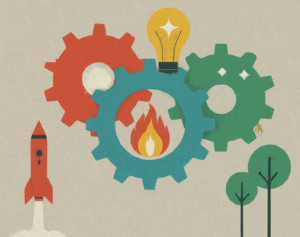With the relentless flow of information and an ever-growing list of tasks, feelings of overwhelm are all too common. This makes effective task management more important than ever. Surprisingly, dedicating a bit of time to organize and prioritize before tackling your tasks can significantly enhance both your drive and efficiency. Join us as we delve into contemporary methods for setting goals and managing tasks, blending actionable advice with a personalized approach.
Step 1 – Define Your End Goal
Imagine you’re at the helm of a sleek spacecraft, navigating through the vast expanse of the universe. Your end goal is your North Star, guiding you through the cosmic chaos of daily life. Without a clear destination, you’re just drifting aimlessly, unsure of where to direct your energy and focus.
To set a compelling end goal, consider these key elements:
– Be Specific and Measurable: Clearly define what you want to achieve and how you will measure your success. Ambiguity can lead to confusion and lack of direction.
– Align with Personal Values: Your goals should resonate with your core beliefs and values, ensuring that you remain motivated and committed to achieving them.
– Make it Challenging yet Achievable: Strike a balance between pushing your limits and setting realistic expectations. Goals that are too easy may not inspire growth, while those that are too difficult can lead to frustration.
– Visualize the Outcome Vividly: Picture the achievement of your goal in your mind. Visualization can enhance motivation and keep you focused on your path.
As the legendary motivational speaker Zig Ziglar once said, “If you aim at nothing, you will hit it every time.”
This quote resonates deeply with me, as I’ve experienced firsthand the transformative power of having a clear, defined goal to drive my actions and decisions. Without a precise target, it’s easy to get lost in the hustle and bustle of daily tasks, but with a well-defined goal, each step you take brings you closer to your desired destination.

Step 2 – List Down the Steps to Be Followed
Now that you have your grand vision, it’s time to break it down into manageable chunks. Think of your goal as a complex Lego structure. You wouldn’t attempt to build it all at once, would you? Instead, you’d follow the instructions step by step, piece by piece, ensuring that each small component contributes to the bigger picture.
Here’s how you can systematically deconstruct your goal:
1. Identify the Major Components of Your Goal: Start by outlining the main parts that make up your overall objective. These components act as the framework for your plan.
2. Break These Components into Smaller Tasks: Divide each major component into smaller, actionable tasks. This makes the process less overwhelming and more manageable.
3. Ensure Each Task is Specific and Achievable Within an Hour: Tasks that can be completed in a short period prevent procrastination and build momentum. They should be clear and concise.
4. Create a Master List of These Tasks: Compile all your tasks into a comprehensive list. This list serves as your roadmap, guiding you step by step toward your goal.
To keep your tasks organized and easily accessible, consider using digital task management apps. These tools offer the convenience of accessing your task list across all your devices, ensuring you stay on track no matter where you are. On the other hand, if you prefer a more tactile approach, a bullet journal or a simple notepad can be equally effective. The tactile method offers a satisfying physical interaction with your tasks, making completion feel more tangible.

Step 3 – Prioritize Tasks and Add Deadlines
Imagine you have a time-turner from the Harry Potter universe. While we can’t manipulate time, effective prioritization and deadline-setting can feel like magic in boosting your productivity.
“The key is not to prioritize what’s on your schedule, but to schedule your priorities.” – Stephen Covey
This quote has been a game-changer in my personal productivity journey. Here’s how you can apply this wisdom:
Use the Eisenhower Matrix to categorize tasks:
Urgent and Important:
These tasks require immediate attention. They are both critical and time-sensitive. Examples might include project deadlines or urgent issues that could have significant consequences if not addressed promptly. Do these immediately.
Important but Not Urgent:
These tasks are crucial for your long-term goals but don’t need to be done right away. They might include strategic planning, skill development, or building relationships. Schedule these tasks to ensure they are completed without becoming urgent crises.
Urgent but Not Important:
These tasks demand immediate attention but don’t significantly impact your long-term goals. They could include interruptions, meetings, or requests from others that don’t align with your priorities. Delegate these tasks if possible, freeing up your time for more important activities.
Neither Urgent nor Important:
These tasks are neither critical nor time-sensitive. They might include unnecessary distractions, time-wasting activities, or things that don’t contribute to your goals. Eliminate these tasks to focus on what truly matters.

Set SMART Deadlines:
– Specific: Clearly define what needs to be done. Ambiguity can lead to confusion and delays. For instance, instead of setting a goal to “work on the report,” specify “complete the introduction section of the report.”
– Measurable: Establish criteria for measuring progress. This allows you to track your progress and stay motivated. For example, aim to “write 500 words” rather than just “write.”
– Achievable: Set realistic and attainable deadlines. Overambitious goals can lead to frustration and burnout. Ensure that the tasks are within your capacity and resources.
– Relevant: Align your deadlines with your broader objectives and priorities. Each task should contribute to your overall goals, ensuring that your efforts are directed towards meaningful outcomes.
– Time-bound: Assign a specific timeframe for completion. This creates a sense of urgency and helps you stay focused. For instance, “finish the first draft by Friday” provides a clear deadline.
As the ancient Chinese philosopher Lao Tzu wisely said, “The journey of a thousand miles begins with a single step.” By defining your end goal, breaking it down into manageable tasks, and prioritizing effectively, you’re not just taking that first step—you’re mapping out your entire journey. The path to success isn’t always linear, but with a clear plan and the right mindset, you’re already halfway there. Start small, stay consistent, and watch as your dreams transform into reality, one task at a time.




